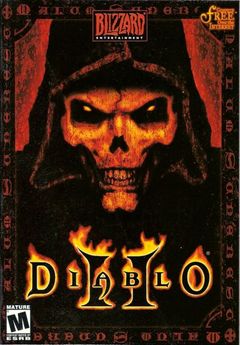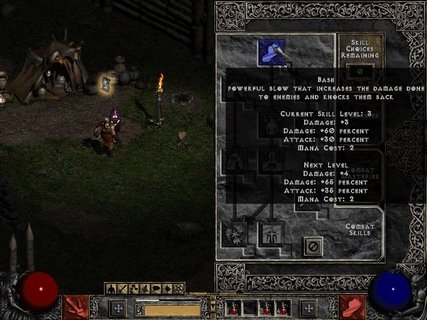Diablo II - History and Gameplay
 On November 30th, 1996 the world was rocked by the release of what is
quite possibly the start of the isometric hack’n’slash genre: Diablo.
It was renowned for its remarkably dark atmosphere, creative character
customization, easy control scheme and extremely in-depth storytelling.
On November 30th, 1996 the world was rocked by the release of what is
quite possibly the start of the isometric hack’n’slash genre: Diablo.
It was renowned for its remarkably dark atmosphere, creative character
customization, easy control scheme and extremely in-depth storytelling.
Not only did it have all of this, it also had online multiplayer via a free service called Battle.net that is also host to virtually all of Blizzard's games.
After a few years of garnering international success, it was announced that a sequel was in the works. Diablo II was released on June 29th, 2000. For me, educationally, it was all downhill from there.
This is part one of a multi-part review and historical remembrance of Diablo II. We also played the first hour of Diablo II a few years ago.
This was the first game ever that I purchased the day it came out, I bought it from Wal-Mart for $50. I remember its enormous installation of 1.55GB and the use of multiple CDs to install the game. Compared to other games I had played (such as Rollercoaster Tycoon, which only used up 170 MB for a full installation.), this was a beast that had me more excited than any other game I had played.
After the install, I clicked play. I was so eager that I clicked through the opening credits and immediately created my first character: a barbarian. I watched the first cinematic in awe, and then the next thing I knew, I was in the Rogue Encampment, with no idea what I was in for because I had never played the original.
I started playing online two days later, as my brother Nathon had also purchased they game and we thought it would be fun to play together. That time, I created a paladin, and this was the first time I had ever been truly addicted to a game. It only got worse when the expansion, Diablo II: Lord of Destruction, was released.
Gameplay
 The game is what the creators at Blizzard deem “Kill/Reward.” This is a much more common in games now, and the reason why is because it is so addicting. It’s really simple; it’s the chance of discovering new, more powerful items that creates a sense of obligation to continuously kill things. This, on top of the fact that killing monsters garners experience makes it even worse.
The game is what the creators at Blizzard deem “Kill/Reward.” This is a much more common in games now, and the reason why is because it is so addicting. It’s really simple; it’s the chance of discovering new, more powerful items that creates a sense of obligation to continuously kill things. This, on top of the fact that killing monsters garners experience makes it even worse.
The game also is what many of my friends called “click-click-die.” This game has actually taken the lives of two of my computer mice. You control yourself almost entirely with the mouse, hence “click-click-die.” My dad even noted, humorously, that he could tell when my brother and I were fighting in harder areas because there were fewer pauses between the clicks.
So, let’s get personal, how does the game actually play? Well, it works very well, honestly. It’s incredibly simplistic, but it’s so shallowly rewarding that you can find yourself playing for hours and hours. This game, even still, forces my body to make me feel like complete shit to get me into bed.
The game implements near endless amounts of weapons and armor to make the game interesting, but what makes the game so replayable is what makes the legendary, and that is what is quite possibly the first ever skill-tree.
In the previous installment of Diablo, you gained different spells and abilities by finding skill tomes that contained skills like “Bone Spirit” which is later found in Diablo II. Because of this, the Real-Time RPG world was changed forever. It’s not surprising when you think about it: this is the company that created World of Warcraft, a game whose skill-trees are legendary and allow you to make your class the exact way you want it. Ever wondered where that idea came from? Well, here it is.
Look forward to part two, where I describe the “Kill/Reward” system in depth, why it works, and why I (along with many others) still love it so much!
